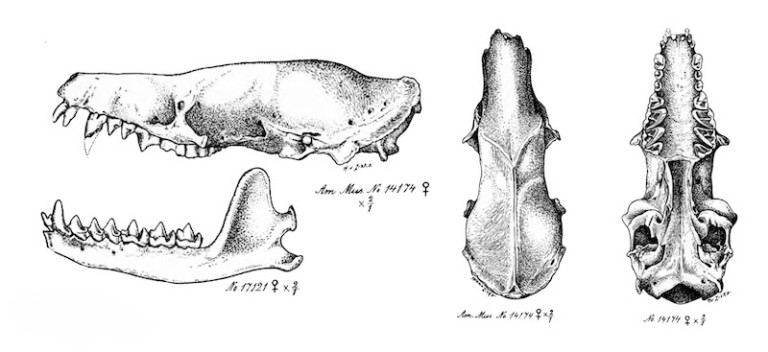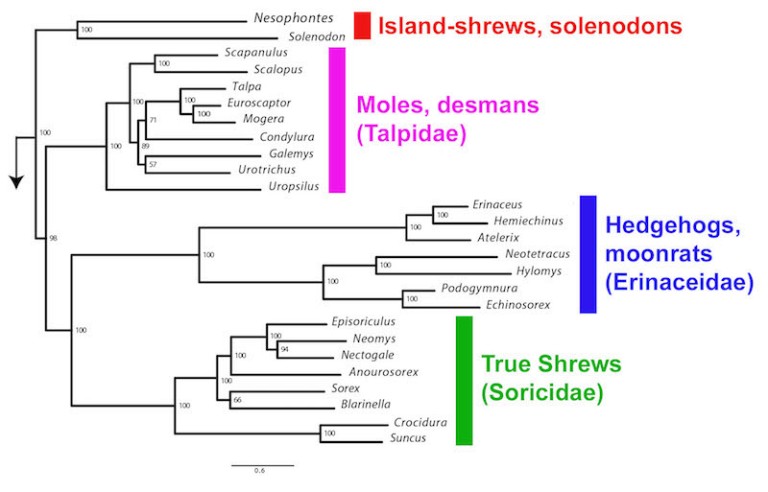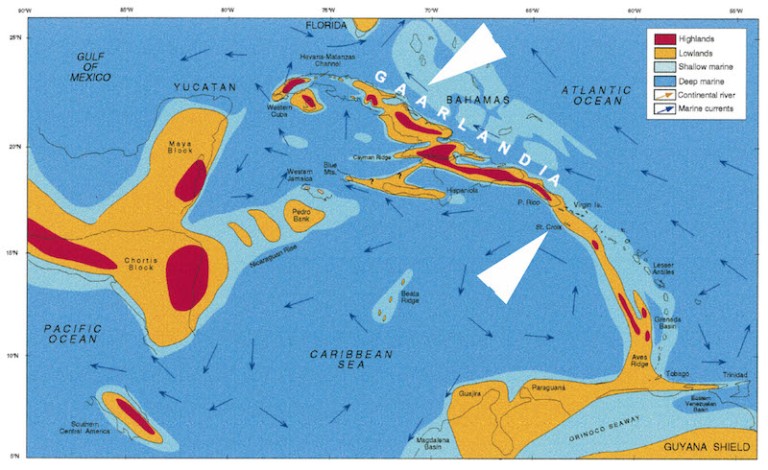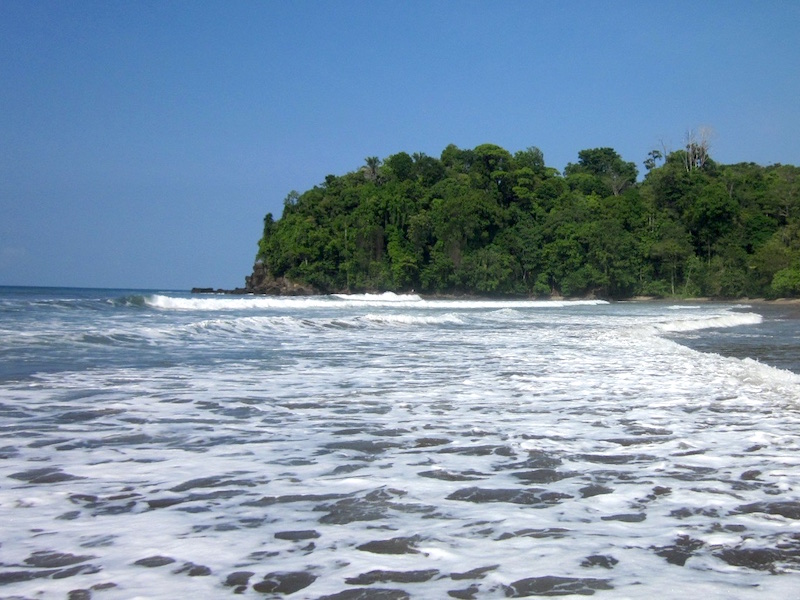The other day, my Twitter feed alerted me to a recently published study by Selina Brace and colleagues on Nesophontes. Never heard of Nesophontes? You are not alone.

First things first: what was Nesophontes? In short, it was a genus of nine species of insectivorous mammals that inhabited what today are various islands of the Caribbean (the Greater Antilles). Species of Nesophontes are collectively referred to as island-shrews*, which gives you some idea of their size and form: small, terrestrial, and probably not very cuddly. In truth, they weren’t all as small as a shrew; the larger species were the size of a mole (Scalopus aquaticus) or chipmunk (Tamias striatus). It is also unknown how cuddly they actually were.
Island-shrews were in the news recently because researchers were able to extract ancient island-shrew DNA and thus provide new data about their evolutionary relationships, which have long been unclear. They found that they are most closely related to solenodons (Solenodon spp.), a group of larger-bodied and also insectivorous Caribbean endemics that includes two extant species. This close relationship may not seem surprising considering that solenodons are the only other mammals in the area remotely similar to island-shrews, but differences in the teeth of these mammals have long cast doubt on a close relationship between them. These new molecular data indicate that island-shrews and solenodons diverged from one another some 68-44 million years ago, plenty of time for their teeth to have evolved in different directions. These data also suggest that the presence of both island-shrews and solenodons in the Greater Antilles can be explained by a single dispersal event.

This leaves one major question: how did the single common ancestor of Nesophontes and Solenodon reach the Greater Antilles? Unfortunately, this answer remains unclear.
A study published by Alfred Roca and colleagues in 2004 demonstrated that this branch of the mammal family tree diverged from that of other mammals near the end of the Mesozoic Era, some 81-72 million years ago. Since ancient relatives of shrews and moles (and presumably island-shrews and solenodons) were present in North America during the early Cenozoic, a land connection between North America and the “proto-Antilles” at this time could have enabled the common ancestor of island-shrews and solenodons to simply walk from one area to the other.
This scenario is appealing in its simplicity but is far from certain. For one, it is challenging to reconstruct ancient coastlines and land connections for this geologically complex region (see Iturralde-Vinent 2006). Additionally, if such a land connection did exist, one might expect other groups of North American mammals to have made the journey to the proto-Antilles. At present, there is no strong evidence that such crossings ever occurred, though the region’s very poor fossil record of terrestrial mammals does not make this a particularly strong line of reasoning. (Absence of evidence is not necessarily evidence of absence.) It is almost certain that the ancestor of island-shrews and solenodons came from North America, but over-water dispersal would seem to be an equally likely explanation, particularly considering the small size of these animals.
The situation is similar for other endemic Greater Antilles mammals – including sloths, caviomorph rodents, and platyrrhine primates – though all of these groups clearly came from South America rather than North America. In 1999, Manuel Iturralde-Vinent and Ross MacPhee proposed that a land connection between northern South America and the Greater Antilles around 35 million years ago dubbed GAARlandia could explain the presence of all of these groups on these islands. This would certainly be a simpler explanation than five or more independent, over-water rafting events, but it does not explain why marsupials or other types of rodents or monkeys did not also make the trek from South America.

In 2014, a pair of studies reached opposite conclusions about whether GAARlandia could have facilitated the arrival of some Greater Antillean rodents. Jorge Vélez-Juarbe and colleagues described a fossil from Puerto Rico that pushed the age of the oldest Caribbean rodents back some 10 million years, much closer to the age expected based on the GAARlandia hypothesis (around 30-35 million years ago). Meanwhile, Pierre-Henri Fabre and colleagues used molecular data to determine that some endemic Caribbean rodents known as hutias diverged from their South American relatives a mere 18-15 million years ago, far too late to have traversed GAARlandia. Since the rodent fossil identified by Vélez-Jaurbe and colleagues is apparently not from a hutia, it is still possible that this older group of rodents crossed GAARlandia, but hutias probably rafted over millions of years later.
A major challenge of historical sciences like paleontology is that sometimes it just isn’t possible to reconstruct the details of certain events in the ancient past. Nevertheless, it is ironic that some of the least-contested examples of over-water dispersal – rodents and monkeys rafting to South America from Africa sometime in the Eocene – are also the least-expected (considering the great distance involved). If one accepts these remarkable feats as fact, then the presence of rodents and monkeys in the Greater Antilles is rather unsurprising, perhaps even expected. What is surprising is continuing to search for land connections to explain how terrestrial mammals reached islands of the Caribbean rather than embracing rafting monkeys (and rodents).
*The hyphen in “island-shrew” indicates that these mammals are not true shrews (i.e., members of the family Soricidae) but rather shrewlike animals.
References Cited
- Anthony, H. E. 1918. The indigenous land mammals of Porto Rico, living and extinct. Memoirs of the American Museum of Natural History 2:331-435.
- Brace, S., J. A. Thomas, L. Dalén, J. Burger, R. D. E. MacPhee, I. Barnes, and S. T. Turvey. 2016. Evolutionary history of the Nesophontidae, the last unplaced Recent mammal family. Molecular Biology and Evolution. doi: 10.1093/molbev/msw186
- Fabre, P.-H., J. T. Vilstrup, M. Raghavan, C. Der Sarkissian, E. Willerslev, E. J. P. Douzery, and L. Orlando. 2014. Rodents of the Caribbean: origin and diversification of hutias unravelled by next-generation museomics. Biology Letters 10:20140266.
- Iturralde-Vinent, M. A. 2006. Meso-Cenozoic Caribbean paleogeography: implications for the historical biogeography of the region. International Geology Review 48:791-827.
- Iturralde-Vinent, M. A., and R. D. E. MacPhee. 1999. Paleogeography of the Caribbean region; implications for Cenozoic biogeography. Bulletin of the American Museum of Natural History 238:1-95.
- Roca, A. L., G. Kahila Bar-Gal, E. Eizirik, K. M. Helgen, R. Maria, M. S. Springer, S. J. O’Brien, and W. J. Murphy. 2004. Mesozoic origin for West Indian insectivores. Nature 429:649-651.
- Vélez-Juarbe, J., T. Martin, R. D. E. Macphee, and D. Ortega-Ariza. 2014. The earliest Caribbean rodents: Oligocene caviomorphs from Puerto Rico. Journal of Vertebrate Paleontology 34:157-163.
